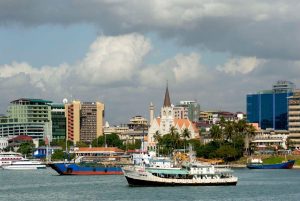Kenya Airways will resume passenger flights on June 8, the Transport Ministry has confirmed.
On the other hand, the Kenya Airports Authority is putting in place the necessary operation manual ahead of the opening of the country’s airports for passengers.
In an interview with the Star, Transport Cabinet Secretary James Macharia said the airline is ready to take back to the skies.
This will however be subject to “medical protocol”, Macharia said, which the government is keen to ensure both the national carrier and KAA comply with.
“We expect KQ to fly from June 8 subject to medical protocols,” he said.
According to industry players, these include clearance by the World Health Organization (WHO) and adherence to set specifics and standards by the International Air Transport Association (IATA).
Among them is spacing at check-ins, waiting bays, sanitising and neutralising of the middle seats in aircraft.
“We are supporting KQ to get back to the skies,” Macharia said.
This week, staff at JKIA were taken through a two-day pandemic preparedness training, a program of the East African Community conducted by AMREF and funded by Germany.
The Sh708.1 million programme covers eight international airports in the six EAC partner States.
It involves a wide range of staff with close contact to passengers and or their luggage, mong them airport medical service providers, aircraft and airline operators, selected crew members, staff at immigration and customs, cargo and baggage handlers.
The training aims to build the knowledge of the staff on safety measures, surveillance, prevention and control strategies and relevant regional guidelines.
“These trainings are implemented at a critical point in time, before international travel picks up again,”German Deputy Ambassador Thomas Wimmer said.
The latest developments give hope to the country’s aviation and travel industry, which has one of the most affected since the government’s suspension on intentional flights in March to curb the spread of the coronavirus.
The airline grounded a majority of its 36 aircraft, which includes nine Boeing 787 Dreamliners, 10 Boeing 737 aircraft, and 17 Embraers.
“We started feeling the effect in February after we stopped flying to China, then Italy and the rest followed,” Kenya Airways CEO Allan Kilavuka told the Star in a recent interview.
KQ, as it is known by its international code, has been competing for cargo business, which is currently the only business available for most airlines.
This is through its two Boeing 737-300 freighters and the use of passenger planes to transport cargo.
KQ has also been flying specially arranged emergency flights, mainly to evacuating citizens stranded abroad, or those seeking to fly back home.
Such is the direct flight from Nairobi to London set for June 4, where subject to sufficient demand, KQ will operate a specially arranged flight which will depart from Nairobi at 9:20 am for London Heathrow.
The economy class ticket is going for approximately $1,333(Sh142, 710) and $2,403 (about Sh257, 265) for business class.
Returning to the skies will be a big relief for the airline which has a network of 53 destinations globally.
Kilavuka yesterday said the airline will start with local flights before moving to regional routes and inter-continental schedules.
“We will start with domestic and regional flights at reduced frequency and then introduce some long haul at reduced frequency and changed based on demand,” he told the Star.
KQ has been losing an estimated Sh9.3 billion in revenue monthly after the suspension of flights.
On Tuesday, it announced a net loss of Sh12.9 billion for the financial year ended December 31, 2019, as operating costs dented its balance sheet.
This is 72 per cent rise compared to the Sh7.5 billion net loss reported for the same period in 2018.
Adoption of IFRS 16 and increase in operating costs associated with a 15 per cent increase in capacity deployed to offer increased connectivity between city pairs and investment in new routes affected the airlines profitability, Chairman Michael Joseph said.
The Nairobi Securities Exchange-listed airline saw a 12.4 per cent increase in operating costs, driven by an increase in capacity deployed and an increase in fleet ownership costs attributed to the return of two Boeing 787 aircraft that had been subleased to Oman Air.
The operating costs eroded gains made in revenues which increased by 12.4 per cent to Sh128.3 billion, up from Sh114.2 billion in 2018.
“The growth was due to improved passenger, cargo, ancillaries, and other revenue streams, mainly due to expansion of the Kenya Airways network,” said Joseph.
Kilavuka has however warned of tough times ahead before the industry fully picks, with passenger and revenue numbers expected to drop by 65 per cent
According to the CEO, the propositions to neutralize the middle seat in aircraft will also increase cost of travel by between 50 and 100 per cent.
Airlines in Europe and parts of Asia have commenced operations, albeit on small-scale, as travelers remain cautious.
Macharia has affirmed government’s support for KQ, which is under the process of nationalization, saying it remains critical for the flower sector, fresh produce exports and the country’s tourism sector.
“KQ goes beyond the balance sheet and profit and losses. If you only look at these, you will never have an airline,” he said on the telephone, “We shall continue supporting KQ.”



